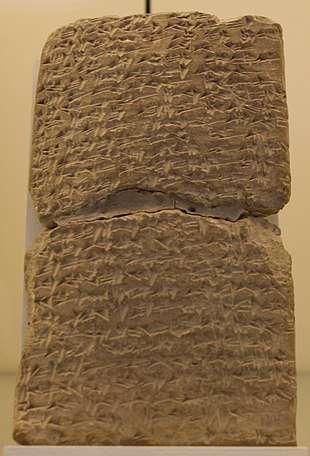Diš
The cuneiform sign ![]()
![]()

| Wikimedia Commons has media related to Diš (cuneiform). |
The sign is also used to denote "numbers of items". The sign is used for 1. Examples of multiple uses in the Amarna letters, is to address the Pharaoh, often as "servant-yours, at 2 Feet, .. I bow." An example of multiple uses in the Amarna letters, often the bowing down is done: " .. 7 and 7 times (I bow) !", with seven small strokes as units of number "1".
In the Epic of Gilgamesh, there are also uses for "diš", and "tiš". (In the Akkadian language, "d" & "t", are interchangeable (voiced vs unvoiced).
The glossenkeil usage of the angled sign
Many of the Amarna letters use glossenkeils, of two varieties: type 1: 𒃵, and type 2: ![]()
The type 2 glossenkeil, is a shortened version of the large-angled-stroke, type 2; (the long stroke of the sign is slightly, or majorly, foreshortened. In the Amarna letters, often down to 50 % of the "full stroke".). The high quality photo of EA 364, line 8, shows the length about 3/4 of a full stroke-length.
Epic of Gilgamesh usage
The ana, (diš) sign usage in the Epic of Gilgamesh is as follows: ana-(151 times); diš-(6); tiš-(6); and 1-(87 times).[1]
See also & Ext link
References
- Parpola, 197l. The Standard Babylonian Epic of Gilgamesh, Sign List, pp. 155-165, no. 480, p. 164, ("ana"), "diš", etc.
- Moran, William L. 1987, 1992. The Amarna Letters. Johns Hopkins University Press, 1987, 1992. 393 pages.(softcover, ISBN 0-8018-6715-0)
- Parpola, 197l. The Standard Babylonian Epic of Gilgamesh, Parpola, Simo, Neo-Assyrian Text Corpus Project, c 1997, Tablet I thru Tablet XII, Index of Names, Sign List, and Glossary-(pp. 119–145), 165 pages.